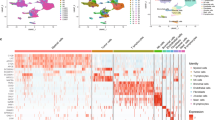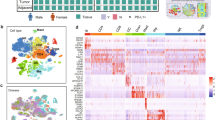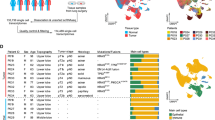Abstract
The adenosine-signaling axis has been recognized as an important immunomodulatory pathway in tumor immunity. However, the biological role of the adenosine-signaling axis in the remodeling of the tumor microenvironment (TME) in lung adenocarcinoma (LUAD) remains unclear. Here, we quantified adenosine signaling (ado_sig) in LUAD samples using the GSVA method and assessed the prognostic value of adenosine in LUAD. Afterward, we explored the heterogeneity of the tumor-immune microenvironment at different adenosine levels. In addition, we analyzed the potential biological pathways engaged by adenosine. Next, we established single-cell transcriptional profiles of LUAD and analyzed cellular composition and cell-cell communication analysis under different adenosine microenvironments. Moreover, we established adenosine-related prognostic signatures (ARS) based on comprehensive bioinformatics analysis and evaluated the efficacy of ARS in predicting immunotherapy. The results demonstrated that adenosine signaling adversely impacted the survival of immune-enriched LUAD. The high-adenosine microenvironment exhibited elevated pro-tumor-immune infiltration, including M2 macrophages and displayed notably increased epithelial-mesenchymal transition (EMT) transformation. Furthermore, adenosine signaling displayed significant associations with the expression patterns and prognostic value of immunomodulators within the TME. Single-cell sequencing data revealed increased fibroblast occupancy and a prominent activation of the SPP1 signaling pathway in the high adenosine-signaling microenvironment. The ARS exhibited promising effectiveness in prognostication and predicting immunotherapy response in LUAD. In summary, overexpression of adenosine can cause a worsened prognosis in the LUAD with abundant immune infiltration. Moreover, increased adenosine levels are associated with pro-tumor-immune infiltration, active EMT transformation, pro-tumor angiogenesis, and other factors promoting cancer progression, which collectively contribute to the formation of an immunosuppressive microenvironment. Importantly, the ARS developed in this study demonstrate high efficacy in evaluating the response to immunotherapy.








Similar content being viewed by others
Data availability
The original contributions presented in the study are included in the article/supplementary material; further inquiries can be directed to the corresponding authors.
References
Alexander M, Kim SY, Cheng H (2020) Update 2020: management of non-small cell lung cancer. Lung 198(6):897–907
Allard B, Allard D, Buisseret L, Stagg J (2020) The adenosine pathway in immuno-oncology. Nat Rev Clin Oncol 17(10):611–629
Alsuliman A, Colak D, Al-Harazi O, Fitwi H, Tulbah A, Al-Tweigeri T et al (2015) Bidirectional crosstalk between PD-L1 expression and epithelial to mesenchymal transition: significance in claudin-low breast cancer cells. Molecular Cancer 14:149
Anderson NR, Minutolo NG, Gill S, Klichinsky M (2021) Macrophage-based approaches for cancer immunotherapy. Cancer Res 81(5):1201–1208
Arab S, Kheshtchin N, Ajami M, Ashurpoor M, Safvati A, Namdar A et al (2017) Increased efficacy of a dendritic cell-based therapeutic cancer vaccine with adenosine receptor antagonist and CD73 inhibitor. Tumour Biol 39(3):1010428317695021
Ayers M, Lunceford J, Nebozhyn M, Murphy E, Loboda A, Kaufman DR et al (2017) IFN-γ-related mRNA profile predicts clinical response to PD-1 blockade. J Clin Invest 127(8):2930–2940
Baca-López K, Mayorga M, Hidalgo-Miranda A, Gutiérrez-Nájera N, Hernández-Lemus E (2012) The role of master regulators in the metabolic/transcriptional coupling in breast carcinomas. PLoS One 7(8):e42678
Bagaev A, Kotlov N, Nomie K, Svekolkin V, Gafurov A, Isaeva O et al (2021) Conserved pan-cancer microenvironment subtypes predict response to immunotherapy. Cancer Cell 39(6):845–865.e7
Bai Y, Zhang X, Zhou J, Guo J, Liu Y, Liang C et al (2023) A2aR on lung adenocarcinoma cells: a novel target for cancer therapy via recruiting and regulating tumor-associated macrophages. Chem Biol Interact 382:110543
Beavis PA, Henderson MA, Giuffrida L, Mills JK, Sek K, Cross RS et al (2017) Targeting the adenosine 2A receptor enhances chimeric antigen receptor T cell efficacy. J Clin Invest 127(3):929–941
Beavis PA, Milenkovski N, Henderson MA, John LB, Allard B, Loi S et al (2015) Adenosine receptor 2A blockade increases the efficacy of anti-PD-1 through enhanced antitumor T-cell responses. Cancer Immunol Res 3(5):506–517
Borowsky J, Haruki K, Lau MC, Dias Costa A, Väyrynen JP, Ugai T et al (2021) Association of Fusobacterium nucleatum with specific T-cell subsets in the colorectal carcinoma microenvironment. Clin Cancer Res 27(10):2816–2826
Castellanos E, Feld E, Horn L (2017) Driven by mutations: the predictive value of mutation subtype in EGFR-mutated non-small cell lung cancer. J Thorac Oncol 12(4):612–623
Cekic C, Day Y-J, Sag D, Linden J (2014) Myeloid expression of adenosine A2A receptor suppresses T and NK cell responses in the solid tumor microenvironment. Cancer Res 74(24):7250–7259
Chen Q, Ma J, Wang X, Zhu X (2022) Identification of prognostic candidate signatures by systematically revealing transcriptome characteristics in lung adenocarcinoma with differing tumor microenvironment immune phenotypes. Aging (Albany NY) 14(11):4786–4818
Collis MG, Hourani SM (1993) Adenosine receptor subtypes. Trends Pharmacol Sci 14(10):360–366
Costa A, Kieffer Y, Scholer-Dahirel A, Pelon F, Bourachot B, Cardon M et al (2018) Fibroblast heterogeneity and immunosuppressive environment in human breast cancer. Cancer Cell 33(3):463–479.e10
Csóka B, Selmeczy Z, Koscsó B, Németh ZH, Pacher P, Murray PJ et al (2012) Adenosine promotes alternative macrophage activation via A2A and A2B receptors. FASEB J 26(1):376–386
D'Ancona S, Ragazzi E, Fassina G, Mazzo M, Gusella M, Berti T (1994) Effect of dipyridamole, 5'-(N-ethyl)-carboxamidoadenosine and 1,3-dipropyl-8-(2-amino-4-chlorophenyl)-xanthine on LOVO cell growth and morphology. Anticancer Res 14(1A):93–97
Escudero C, Bertoglia P, Hernadez M, Celis C, Gonzalez M, Aguayo C et al (2013) Impaired A2A adenosine receptor/nitric oxide/VEGF signaling pathway in fetal endothelium during late- and early-onset preeclampsia. Purinergic Signal 9(2):215–226
Ferrante CJ, Pinhal-Enfield G, Elson G, Cronstein BN, Hasko G, Outram S et al (2013) The adenosine-dependent angiogenic switch of macrophages to an M2-like phenotype is independent of interleukin-4 receptor alpha (IL-4Rα) signaling. Inflammation 36(4):921–931
Fong L, Hotson A, Powderly JD, Sznol M, Heist RS, Choueiri TK et al (2020) Adenosine 2A receptor blockade as an immunotherapy for treatment-refractory renal cell cancer. Cancer Discov 10(1):40–53
García-Rocha R, Monroy-García A, Carrera-Martínez M, Hernández-Montes J, Don-López CA, Weiss-Steider B et al (2022) Evidence that cervical cancer cells cultured as tumorspheres maintain high CD73 expression and increase their protumor characteristics through TGF-β production. Cell Biochem Funct 40(7):760–772
He D, Wang D, Lu P, Yang N, Xue Z, Zhu X et al (2021) Single-cell RNA sequencing reveals heterogeneous tumor and immune cell populations in early-stage lung adenocarcinomas harboring EGFR mutations. Oncogene 40(2):355–368
Hegde PS, Chen DS (2020) Top 10 challenges in cancer immunotherapy. Immunity 52(1):17–35
Herbst RS, Morgensztern D, Boshoff C (2018) The biology and management of non-small cell lung cancer. Nature 553(7689):446–454
Inomata M, Kado T, Okazawa S, Imanishi S, Taka C, Kambara K et al (2019) Peripheral PD1-positive CD4 T-lymphocyte count can predict progression-free survival in patients with non-small cell lung cancer receiving immune checkpoint inhibitor. Anticancer Res 39(12):6887–6893
Inomata M, Matsumoto M, Takata N, Hayashi K, Seto Z, Hirai T et al (2023) Peripheral CD4 memory T cells predict the efficacy of immune checkpoint inhibitor therapy in patients with non-small cell lung cancer. Sci Rep 13(1):10807
Jin S, Guerrero-Juarez CF, Zhang L, Chang I, Ramos R, Kuan C-H et al (2021) Inference and analysis of cell-cell communication using CellChat. Nat Commun 12(1):1088
Kim N, Kim HK, Lee K, Hong Y, Cho JH, Choi JW et al (2020) Single-cell RNA sequencing demonstrates the molecular and cellular reprogramming of metastatic lung adenocarcinoma. Nat Commun 11(1):2285
Kleczko EK, Kwak JW, Schenk EL, Nemenoff RA (2019) Targeting the complement pathway as a therapeutic strategy in lung cancer. Front Immunol 10:954
Kornepati AVR, Vadlamudi RK, Curiel TJ (2022) Programmed death ligand 1 signals in cancer cells. Nat Rev Cancer 22(3):174–189
Li X, Zhang Q, Chen G, Luo D (2021) Multi-omics analysis showed the clinical value of gene signatures of C1QC+ and SPP1+ TAMs in cervical cancer. Front Immunol 12:694801
Liang W, Zhao Y, Huang W, Gao Y, Xu W, Tao J et al (2019) Non-invasive diagnosis of early-stage lung cancer using high-throughput targeted DNA methylation sequencing of circulating tumor DNA (ctDNA). Theranostics 9(7):2056–2070
Liu H, Kuang X, Zhang Y, Ye Y, Li J, Liang L et al (2020) ADORA1 inhibition promotes tumor immune evasion by regulating the ATF3-PD-L1 axis. Cancer Cell 37(3):324–339.e8
Long R, Abulimiti N, Wang X (2023) Proteomics-based clustering of lung adenocarcinoma identifies three subtypes with significantly different clinical and molecular features. Clin Transl Oncol
Lu T, Yang X, Huang Y, Zhao M, Li M, Ma K et al (2019) Trends in the incidence, treatment, and survival of patients with lung cancer in the last four decades. Cancer Manag Res 11:943–953
Madsen DH, Leonard D, Masedunskas A, Moyer A, Jürgensen HJ, Peters DE et al (2013) M2-like macrophages are responsible for collagen degradation through a mannose receptor-mediated pathway. J Cell Biol 202(6):951–966
Matsubara E, Yano H, Pan C, Komohara Y, Fujiwara Y, Zhao S et al (2023) The significance of SPP1 in lung cancers and its impact as a marker for protumor tumor-associated macrophages. Cancers (Basel) 15(8):2250
Mazzi P, Caveggion E, Lapinet-Vera JA, Lowell CA, Berton G (2015) The Src-family kinases Hck and Fgr regulate early lipopolysaccharide-induced myeloid cell recruitment into the lung and their ability to secrete chemokines. J Immunol 195(5):2383–2395
Mediavilla-Varela M, Luddy K, Noyes D, Khalil FK, Neuger AM, Soliman H et al (2013) Antagonism of adenosine A2A receptor expressed by lung adenocarcinoma tumor cells and cancer associated fibroblasts inhibits their growth. Cancer Biol Ther 14(9):860–868
Mittal D, Young A, Stannard K, Yong M, Teng MWL, Allard B et al (2014) Antimetastatic effects of blocking PD-1 and the adenosine A2A receptor. Cancer Res 74(14):3652–3658
Murray PJ, Allen JE, Biswas SK, Fisher EA, Gilroy DW, Goerdt S et al (2014) Macrophage activation and polarization: nomenclature and experimental guidelines. Immunity 41(1):14–20
Nallasamy P, Nimmakayala RK, Karmakar S, Leon F, Seshacharyulu P, Lakshmanan I et al (2021) Pancreatic tumor microenvironment factor promotes cancer stemness via SPP1-CD44 axis. Gastroenterology 161(6):1998–2013.e7
Ohta A, Gorelik E, Prasad SJ, Ronchese F, Lukashev D, Wong MKK et al (2006) A2A adenosine receptor protects tumors from antitumor T cells. Proc Natl Acad Sci USA 103(35):13132–13137
Ohta A, Kini R, Ohta A, Subramanian M, Madasu M, Sitkovsky M (2012) The development and immunosuppressive functions of CD4(+) CD25(+) FoxP3(+) regulatory T cells are under influence of the adenosine-A2A adenosine receptor pathway. Front Immunol 3:190
Pastushenko I, Blanpain C (2019) EMT transition states during tumor progression and metastasis. Trends Cell Biol 29(3):212–226
Pignon J-P, Tribodet H, Scagliotti GV, Douillard J-Y, Shepherd FA, Stephens RJ et al (2008) Lung adjuvant cisplatin evaluation: a pooled analysis by the LACE Collaborative Group. J Cli Oncol 26(21):3552–3559
Pinna A (2014) Adenosine A2A receptor antagonists in Parkinson’s disease: progress in clinical trials from the newly approved istradefylline to drugs in early development and those already discontinued. CNS Drugs 28(5):455–474
Qian B-Z, Pollard JW (2010) Macrophage diversity enhances tumor progression and metastasis. Cell 141(1):39–51
Roh W, Chen P-L, Reuben A, Spencer CN, Prieto PA, Miller JP et al (2017) Integrated molecular analysis of tumor biopsies on sequential CTLA-4 and PD-1 blockade reveals markers of response and resistance. Sci Transl Med 9(379):eaah3560
Rooney MS, Shukla SA, Wu CJ, Getz G, Hacohen N (2015) Molecular and genetic properties of tumors associated with local immune cytolytic activity. Cell 160(1-2):48–61
Ryzhov S, Novitskiy SV, Goldstein AE, Biktasova A, Blackburn MR, Biaggioni I et al (2011) Adenosinergic regulation of the expansion and immunosuppressive activity of CD11b+Gr1+ cells. J Immunol 187(11):6120–6129
Ryzhov S, Novitskiy SV, Zaynagetdinov R, Goldstein AE, Carbone DP, Biaggioni I et al (2008) Host A(2B) adenosine receptors promote carcinoma growth. Neoplasia 10(9):987–995
Ryzhov SV, Pickup MW, Chytil A, Gorska AE, Zhang Q, Owens P et al (2014) Role of TGF-β signaling in generation of CD39+CD73+ myeloid cells in tumors. J Immunol 193(6):3155–3164
Shi D, Mu S, Pu F, Zhong B, Hu B, Muhtar M et al (2022) Pan-sarcoma characterization of lncRNAs in the crosstalk of EMT and tumour immunity identifies distinct clinical outcomes and potential implications for immunotherapy. Cell Mol Life Sci 79(8):427
Shi L, Wu Z, Miao J, Du S, Ai S, Xu E et al (2019) Adenosine interaction with adenosine receptor A2a promotes gastric cancer metastasis by enhancing PI3K-AKT-mTOR signaling. Mol Biol Cell 30(19):2527–2534
Sidders B, Zhang P, Goodwin K, O'Connor G, Russell DL, Borodovsky A et al (2020) Adenosine signaling is prognostic for cancer outcome and has predictive utility for immunotherapeutic response. Clin Cancer Res 26(9):2176–2187
Sun H, Liu S-Y, Zhou J-Y, Xu J-T, Zhang H-K, Yan H-H et al (2020) Specific TP53 subtype as biomarker for immune checkpoint inhibitors in lung adenocarcinoma. EBioMedicine 60:102990
Sung H, Ferlay J, Siegel RL, Laversanne M, Soerjomataram I, Jemal A et al (2021) Global Cancer Statistics 2020: GLOBOCAN estimates of incidence and mortality worldwide for 36 cancers in 185 countries. CA: a Cancer J Clin 71(3):209–249
Tang F, Barbacioru C, Wang Y, Nordman E, Lee C, Xu N et al (2009) mRNA-Seq whole-transcriptome analysis of a single cell. Nat Methods 6(5):377–382
Tang H, Chen J, Han X, Feng Y, Wang F (2021) Upregulation of SPP1 is a marker for poor lung cancer prognosis and contributes to cancer progression and cisplatin resistance. Front Cell Dev Biol 9:646390
Tang Z, Wang L, Bajinka O, Wu G, Tan Y (2022) Abnormal gene expression regulation mechanism of myeloid cell nuclear differentiation antigen in lung adenocarcinoma. Biology (Basel) 11(7):1047
Thorsson V, Gibbs DL, Brown SD, Wolf D, Bortone DS, Ou Yang T-H et al (2018) The immune landscape of cancer. Immunity 48(4):812–830.e14
Turcotte M, Spring K, Pommey S, Chouinard G, Cousineau I, George J et al (2015) CD73 is associated with poor prognosis in high-grade serous ovarian cancer. Cancer Res 75(21):4494–4503
Ugai T, Väyrynen JP, Haruki K, Akimoto N, Lau MC, Zhong R et al (2022) Smoking and incidence of colorectal cancer subclassified by tumor-associated macrophage infiltrates. J Natl Cancer Inst 114(1):68–77
Uras IZ, Moll HP, Casanova E (2020) Targeting KRAS mutant non-small-cell lung cancer: past, present and future. Int J Mol Sci 21(12):4325
Vijayan D, Young A, Teng MWL, Smyth MJ (2017) Targeting immunosuppressive adenosine in cancer. Nat Rev Cancer 17(12):709–724
Wang G, Xu D, Zhang Z, Li X, Shi J, Sun J et al (2021) The pan-cancer landscape of crosstalk between epithelial-mesenchymal transition and immune evasion relevant to prognosis and immunotherapy response. NPJ Precis Oncol 5(1):56
Willingham SB, Ho PY, Hotson A, Hill C, Piccione EC, Hsieh J et al (2018) A2AR antagonism with CPI-444 induces antitumor responses and augments efficacy to anti-PD-(L)1 and anti-CTLA-4 in preclinical models. Cancer Immunol Res 6(10):1136–1149
Willingham SB, Hotson AN, Miller RA (2020) Targeting the A2AR in cancer; early lessons from the clinic. Curr Opin Pharmacol 53:126–133
Wu F, Fan J, He Y, Xiong A, Yu J, Li Y et al (2021) Single-cell profiling of tumor heterogeneity and the microenvironment in advanced non-small cell lung cancer. Nat Commun 12(1):2540
Xu J-Y, Zhang C, Wang X, Zhai L, Ma Y, Mao Y et al (2020) Integrative proteomic characterization of human lung adenocarcinoma. Cell 182(1):245–261.e17
Yang L, He Y-T, Dong S, Wei X-W, Chen Z-H, Zhang B et al (2022) Single-cell transcriptome analysis revealed a suppressive tumor immune microenvironment in EGFR mutant lung adenocarcinoma. J Immunother Cancer 10(2):e003534
Yoshihara K, Shahmoradgoli M, Martínez E, Vegesna R, Kim H, Torres-Garcia W et al (2013) Inferring tumour purity and stromal and immune cell admixture from expression data. Nat Commun 4:2612
Young A, Mittal D, Stagg J, Smyth MJ (2014) Targeting cancer-derived adenosine: new therapeutic approaches. Cancer Discov 4(8):879–888
Young A, Ngiow SF, Gao Y, Patch A-M, Barkauskas DS, Messaoudene M et al (2018) A2AR adenosine signaling suppresses natural killer cell maturation in the tumor microenvironment. Cancer Res 78(4):1003–1016
Yu M, Guo G, Huang L, Deng L, Chang C-S, Achyut BR et al (2020) CD73 on cancer-associated fibroblasts enhanced by the A2B-mediated feedforward circuit enforces an immune checkpoint. Nat Commun 11(1):515
Zarek PE, Huang C-T, Lutz ER, Kowalski J, Horton MR, Linden J et al (2008) A2A receptor signaling promotes peripheral tolerance by inducing T-cell anergy and the generation of adaptive regulatory T cells. Blood 111(1):251–259
Zhang L, Li Z, Skrzypczynska KM, Fang Q, Zhang W, O'Brien SA et al (2020) Single-cell analyses inform mechanisms of myeloid-targeted therapies in colon cancer. Cell 181(2):442–459.e29
Zhang Y, Du W, Chen Z, Xiang C (2017) Upregulation of PD-L1 by SPP1 mediates macrophage polarization and facilitates immune escape in lung adenocarcinoma. Exp Cell Res 359(2):449–457
Zhang Y, Zhang Z (2020) The history and advances in cancer immunotherapy: understanding the characteristics of tumor-infiltrating immune cells and their therapeutic implications. Cell Mol Immunol 17(8):807–821
Acknowledgements
We are grateful to the patients and staff who participated in GEO and TCGA.
Funding
This study was sponsored by the National Natural Science Foundation of China (81971483); the Collaborative Innovation Project of Colleges and Universities of Anhui Province (GXXT-2020-058); Anhui Province Engineering Laboratory of Occupational Health and Safety (AYZJSGCLK202201001, AYZJSGCLK202201002, AYZJSGCLK 202202001); Key Laboratory of Industrial Dust Deep Reduction and Occupational Health and Safety of Anhui Higher Education Institutes (AYZJSGXLK202202002); the Innovation and Entrepreneurship Project of Anhui University of Science and Technology (2021CX2125, 2021CX2126, 2021CX2124); and Scientific Research Foundation for High-level Talents of Anhui University of Science and Technology (2022y jrc14).
Author information
Authors and Affiliations
Contributions
HD, BY, and WJ: conception and design this manuscript. HT prepared the original data and drafted the manuscript. XYR, ZJW, and GJQ: development of methodology, analysis and interpretation of data, and writing of the manuscript. MR, XZ, and LY: review of the manuscript.
Corresponding authors
Ethics declarations
Ethics approval and consent to participate
This study was approved by the medical ethics committee of Anhui University of Science and Technology (NO.HX-002).
Consent for publication
Not applicable
Competing interests
The authors declare no competing interests.
Additional information
Publisher’s note
Springer Nature remains neutral with regard to jurisdictional claims in published maps and institutional affiliations.
Rights and permissions
Springer Nature or its licensor (e.g. a society or other partner) holds exclusive rights to this article under a publishing agreement with the author(s) or other rightsholder(s); author self-archiving of the accepted manuscript version of this article is solely governed by the terms of such publishing agreement and applicable law.
About this article
Cite this article
Han, T., Wu, J., Liu, Y. et al. Integrating bulk-RNA sequencing and single-cell sequencing analyses to characterize adenosine-enriched tumor microenvironment landscape and develop an adenosine-related prognostic signature predicting immunotherapy in lung adenocarcinoma. Funct Integr Genomics 24, 19 (2024). https://doi.org/10.1007/s10142-023-01281-z
Received:
Revised:
Accepted:
Published:
DOI: https://doi.org/10.1007/s10142-023-01281-z




